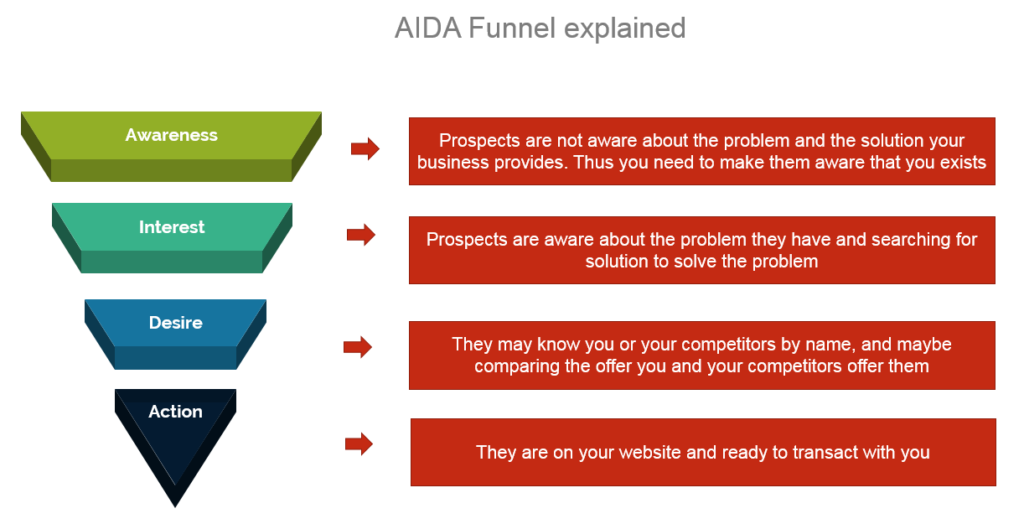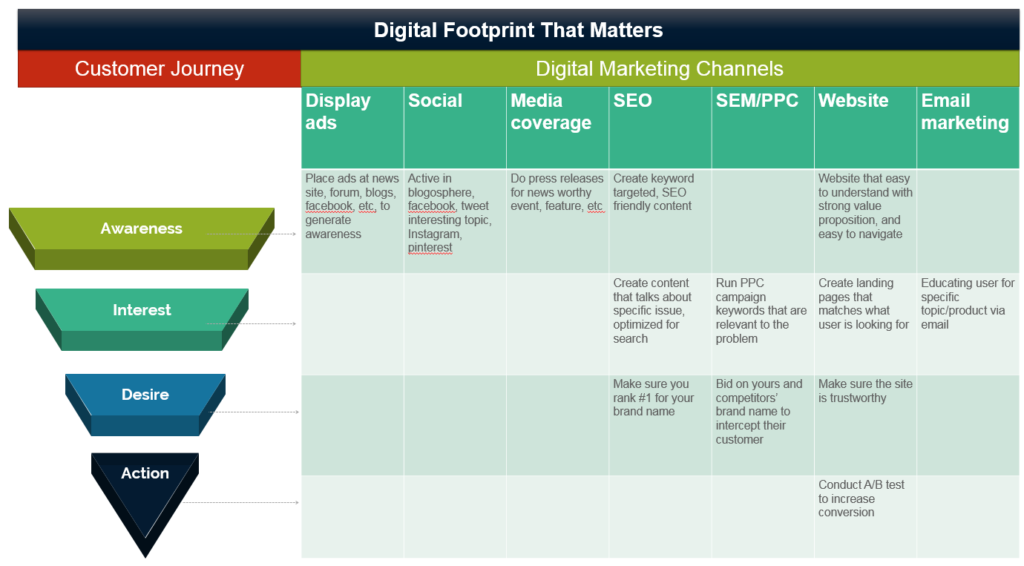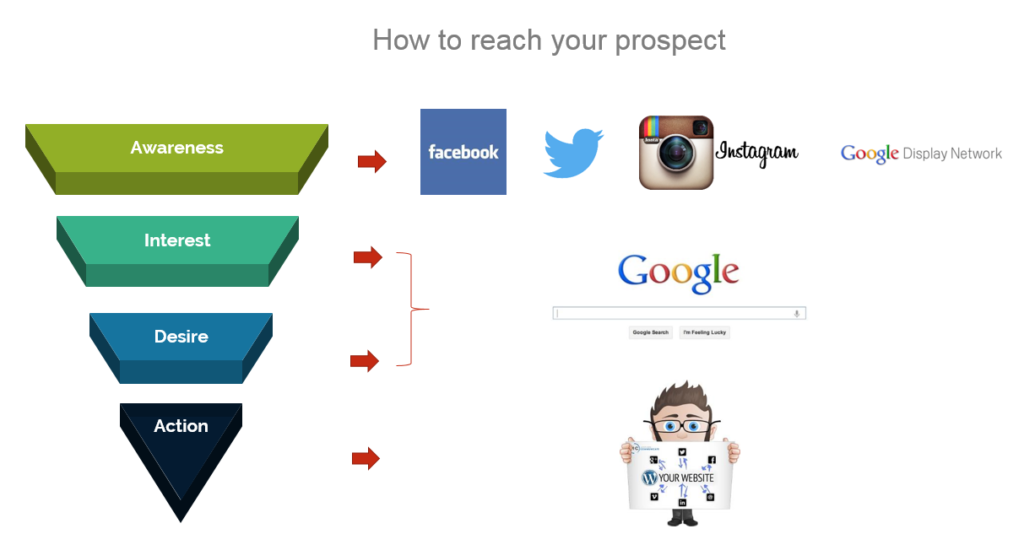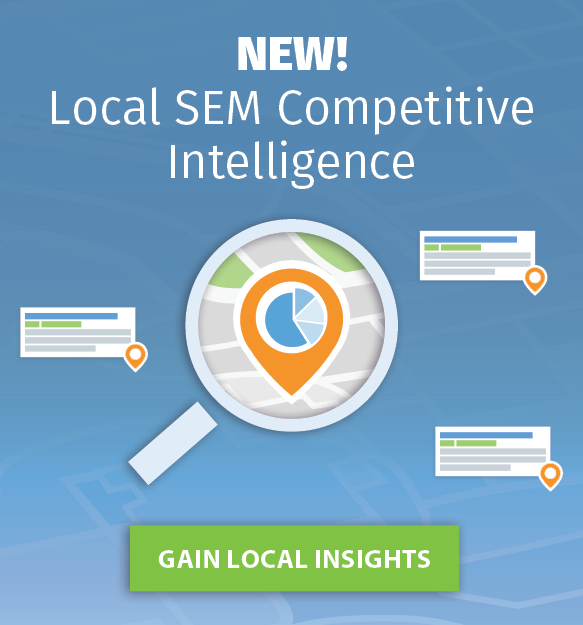In this day and age every business owners know that having a digital footprint is a pre-requisite to growing their business.

So when you hear the phrase “digital footprint”, what comes to mind?
- Having a website?
- Having a great conversion funnel?
- Ranking highly in organic search for your main keywords? (SEO)
- A Google Adwords campaign that converts? (PPC)
- Engaging your customer or prospect in Facebook, Twitter, and Instagram? (Social media)
- Great email campaigns?
- An active, insightful, blog that gets updated on a weekly basis? (Content)
- Live chat functionality on your site perhaps? (CRO)
- Webinars, guest posts, affiliate programs, and on and on…
Are you overwhelmed yet? It’s a lot to digest, not to mention it takes different skill sets to be good at each of them.
In this post I want to help you understand which “digital footprint” matters the most. And hopefully when you realize that, you can then start prioritizing according for your business specific needs.
So let’s start with the end goal in mind, and then start going backward from there.
What’s the End Goal?
The end goal is to increase your business revenue through your website, which means…
You need to have a website that converts.
And in order to have a website that converts, you’ll need traffic you can convert.
And to generate traffic that converts, you need for people to be able to find your website.
In order for people to find your website, you need to be where they are when:
- They’re looking for you, or
- They’re having a problem, searching for a solution, and your product/service solves that their problem, or
- They don’t know even know that they have a problem, and you make them aware of that problem and offer them a solution.
That’s pretty much it. That is the most important things for you to know…at a high level of course.
All of the other things that I mentioned earlier (Social media, SEO, PPC, having a website that converts, email campaigns) falls within the “digital footprint” narrative outlined above.
Let’s use an example:
 Obambam, started a digital marketing agency for the health care businesses in his town. He then named his digital marketing agency to be something intuitive, ObambamCare Digital Marketing Agency
Obambam, started a digital marketing agency for the health care businesses in his town. He then named his digital marketing agency to be something intuitive, ObambamCare Digital Marketing Agency
His goal was to reach the physical therapists in his town. But all of these doctors and physical therapist didn’t know that ObambamCare exists.
So Obambam needed to make them AWARE that by using his service, physical therapists will get more business leads.
That means he needs to create an awareness that ObambamCare exists by running display ads in the physical therapist forum. He also hangs out with some of his physical therapist friends, take a few selfies, and tags them in his Facebook and Instagram accounts.
 At the same time, Michelle, who is a millennial and just graduated from the best physical therapy college in town, realized that she needs to start running some Facebook ads and Google Adwords campaigns for her newly established practice and website…but, she’s a physical therapist, not an internet marketer. She’s interested to find someone who can help her run digital marketing campaign.
At the same time, Michelle, who is a millennial and just graduated from the best physical therapy college in town, realized that she needs to start running some Facebook ads and Google Adwords campaigns for her newly established practice and website…but, she’s a physical therapist, not an internet marketer. She’s interested to find someone who can help her run digital marketing campaign.
She decides to type “social media consultant” into Google. Of course, Obambam, as an expert in digital marketing, runs a search marketing campaign that triggers ObambamCare ads when someone types in “social media consultant.”
Michelle then clicks the ad and lands on the ObambamCare Digital Marketing Agency website.
She learns about the service the website offers, which includes Social Media Services.
She’s tempted but she doesn’t contact him right away because she was not ready yet.
ObambamCare Digital Marketing Agency website offers her to download the “7 deadly mistakes for physical therapist in digital marketing” guide in exchange for her email address.
She thinks to herself… this is what I need!
So she submits her email address, and sure enough, Obambam’s marketing automation kicks in, sending her the warm welcome email with a link where she can download the PDF guide..
She also went to her physical therapy forum to ask if anyone knows about a good digital marketer that she can hire. While in the forum, ObambamCare Digital Marketing Agency ads show up.

She thinks to herself, “Wow this guy is everywhere.”
Little did she knew that what she saw was Obambam’s retargeting campaign in action.
Exhausted for the a full day of researching, she decided to take a break and went to her Facebook only to see her mentor, Barbara, had a picture taken with, guess who? You’re right, Obambam!
Now that she sees Obambam everywhere, in her Facebook, in her inbox, on Google search result pages, even in the physical-therapist forum, she’s ready to engage.
She now has a desire to talk to him.
She goes to ObambamCare Digital Marketing Agency website again, and takes the action to fill up a form to get contacted by Obambam.
The AIDA Funnel Explained
The story above illustrates the customer journey over time that normally looks like this:

You see, your prospect, at any given moment in time falls into one of the stages above.
The Facebook, Instagram, PPC, website, and email campaign are all just channels to reach your prospect digitally, and push them closer to the action stage, whether it’s buying from your e-commerce store, subscribing to your SaaS software, purchasing your information product, or asking to be contacted for your service.
Here are the common channels and the activity within each:

Essentially you want to leave your “Digital footprint” for your prospect to find and follow you for each of the channels and for each steps of their journey to buy your product.
To make this easy to understand, I created the framework below that maps the customer buying cycle with the channels you normally can use to reach your prospects.

Why Do You Need to Internalize This Framework?
In short, it’s to manage expectations for each channel.
You can attach wings and a horn onto a horse, but the poor horse won’t be able to fly and it won’t become a unicorn.
In other words, you can spend tons of money on social media and display ads to get a huge amount of traffic to your website, but those channels are mostly useful for creating Awareness. Thus you’ll see very little conversion from the traffic. You may get a good number of downloads for your free offer, but most likely these prospect won’t convert into a buying customer right away. They’re just not ready to buy your flagship product yet.
You can also add tons of barely-relevant keywords on your PPC campaign, but that channel is appropriate for prospects that already has interest in solving their problem with your product/service. Thus, getting un-targeted traffic through PPC campaign to create “Awareness” of your product/service will not bring you the positive ROI you expect. There’s always exceptions for those who really know what they’re doing, those whose conversion engine has been tuned in. But these “unicorn” digital marketers are more of an exception than the norm.
In Summary
Whether you are a business or a consultant make sure that you understand the function of each marketing channel. This allows you to create an effective strategy that leaves the footprint for your prospect to follow to your web site.
To make it easy to remember here is what you need to internalize the above framework.

About the Author
 Leon Krishnayana is the founder and CEO of iSpionage.com. iSpionage provides market intelligence data to help businesses and agencies come up with a stand-out, high-converting digital marketing strategy, specifically for improving search engine marketing (SEM) campaigns.
Leon Krishnayana is the founder and CEO of iSpionage.com. iSpionage provides market intelligence data to help businesses and agencies come up with a stand-out, high-converting digital marketing strategy, specifically for improving search engine marketing (SEM) campaigns.










